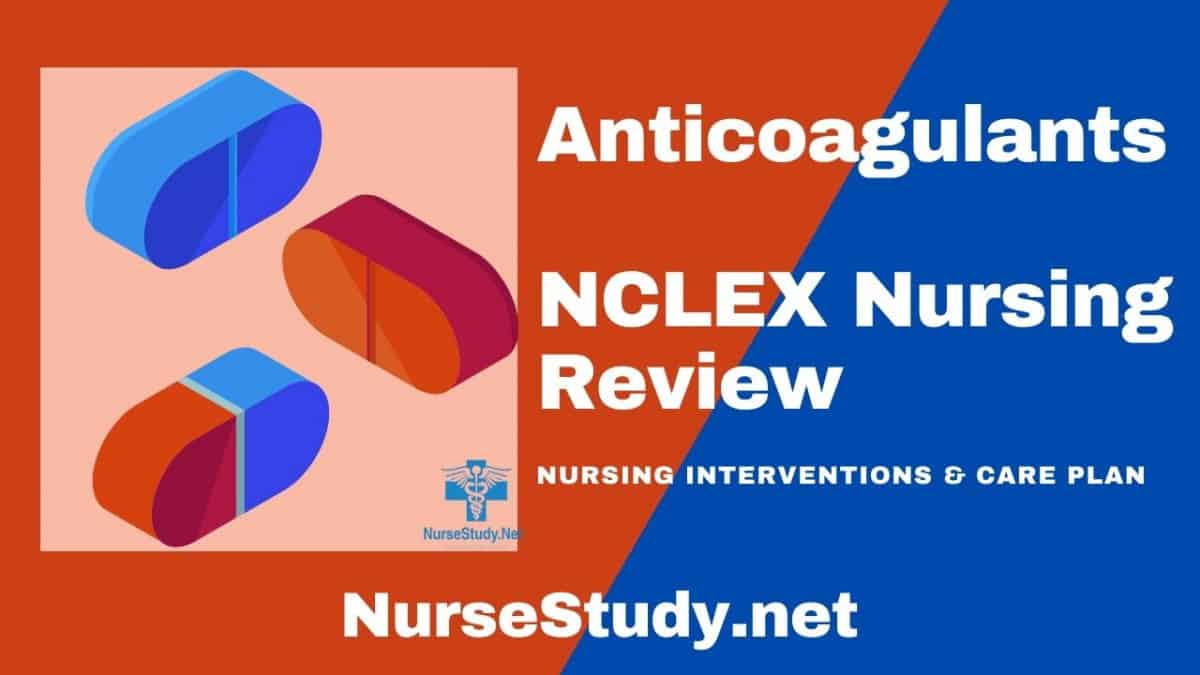Anticoagulants, also known as blood thinners, are medications that prevent blood clot formation and reduce the risk of stroke, heart attack, and other thromboembolic conditions. These medications require careful nursing consideration due to their narrow therapeutic window and potential for serious complications.
Generic names: Warfarin, Heparin, Enoxaparin, Dabigatran, Rivaroxaban, Apixaban
Brand names:
- Warfarin (Coumadin, Jantoven)
- Enoxaparin (Lovenox)
- Dabigatran (Pradaxa)
- Rivaroxaban (Xarelto)
- Apixaban (Eliquis)
Pharmacologic class: Anticoagulants
Therapeutic class: Blood thinners, anticlotting agents
Mechanism of action: Different anticoagulants work through various mechanisms:
- Warfarin: Inhibits vitamin K-dependent clotting factors
- Heparin: Activates antithrombin III to prevent clot formation
- Direct Oral Anticoagulants (DOACs): Directly inhibit specific clotting factors
Indications for use:
- Prevention and treatment of deep vein thrombosis (DVT)
- Prevention and treatment of pulmonary embolism (PE)
- Prevention of stroke in atrial fibrillation
- Prevention of clots in mechanical heart valves
- Post-surgical thromboprophylaxis
Precautions and contraindications:
- Active bleeding or significant risk of bleeding
- Severe liver or kidney disease
- Recent surgery or trauma
- History of intracranial hemorrhage
- Pregnancy (warfarin)
- Severe hypertension
- Thrombocytopenia
Drug Interactions
- NSAIDs increase bleeding risk
- Antibiotics can affect warfarin metabolism
- Antiplatelet medications increase bleeding risk
- Some herbal supplements (garlic, ginger, ginkgo)
- Vitamin K-rich foods affect warfarin effectiveness
Adverse Effects
- Bleeding (major and minor)
- Bruising
- Gastrointestinal upset
- Skin necrosis (warfarin)
- Hair loss
- Osteoporosis (long-term heparin use)
- Heparin-induced thrombocytopenia
Administration Considerations
Available preparations:
- Oral tablets (warfarin, DOACs)
- Subcutaneous injections (enoxaparin, heparin)
- Intravenous solutions (heparin)
Monitoring Parameters:
- INR for warfarin (target usually 2-3)
- aPTT for heparin
- CBC, particularly platelet count
- Renal and hepatic function
- Signs of bleeding
Nursing Considerations for Anticoagulants
Related Nursing Diagnoses
- Risk for bleeding related to anticoagulation therapy
- Risk for injury related to the altered clotting mechanism
- Knowledge deficit related to anticoagulation management
- Risk for ineffective therapeutic regimen management
- Risk for falls related to potential bleeding complications
Nursing Assessment
- Perform comprehensive bleeding risk assessment
- Monitor for signs and symptoms of bleeding:
- Unusual bruising
- Nosebleeds
- Blood in urine or stool
- Excessive menstrual bleeding
- Headache or dizziness
- Assess medication compliance and understanding
- Evaluate fall risk
- Monitor laboratory values as indicated
- Assess for drug-drug and drug-food interactions
Nursing Interventions
- Regular monitoring of appropriate coagulation tests
- Use the smallest gauge needle for injections
- Apply pressure to injection sites for a full 5 minutes
- Implement fall precautions
- Monitor vital signs regularly
- Document and report any signs of bleeding
- Coordinate care with the healthcare team
- Provide patient education
Patient Teaching Associated with Anticoagulants
- Importance of medication adherence and consistent timing
- Signs and symptoms of bleeding to report immediately:
- Severe headache
- Unusual bruising
- Blood in urine or stool
- Prolonged bleeding from cuts
- Excessive menstrual bleeding
- Lifestyle modifications:
- Avoid high-impact activities
- Use soft toothbrush
- Electric razor for shaving
- Wear a medical alert bracelet
- Dietary considerations:
- Consistent vitamin K intake (for warfarin)
- Avoid alcohol
- Maintain consistent diet
- Laboratory monitoring requirements
- The importance of informing all healthcare providers about anticoagulation
- When to seek emergency care
- Proper storage and handling of medications
This is not an all-inclusive list of possible drug interactions, adverse effects, precautions, nursing considerations, or patient instructions. Please consult further with a pharmacist for complete information.
References
- Schaefer, J. K., & Barnes, G. D. (2023). Anticoagulation for Atrial Fibrillation. JAMA, 329(7), 566-567. https://doi.org/10.1001/jama.2023.0374
- Garcia, D. A., & Crowther, M. A. (2023). Management of bleeding in patients receiving oral anticoagulants. New England Journal of Medicine, 388(6), 549-560.
- Kearon, C., & Akl, E. A. (2022). Duration of anticoagulation for deep vein thrombosis and pulmonary embolism. Blood, 139(15), 2294-2313.
- Tritschler, T., & Castellucci, L. A. (2023). Anticoagulation in special populations. Thrombosis Research, 221, 43-51.
